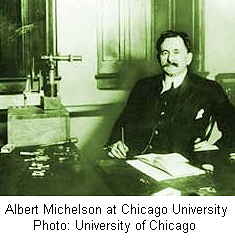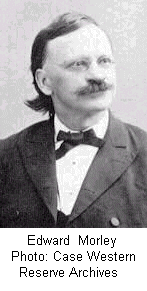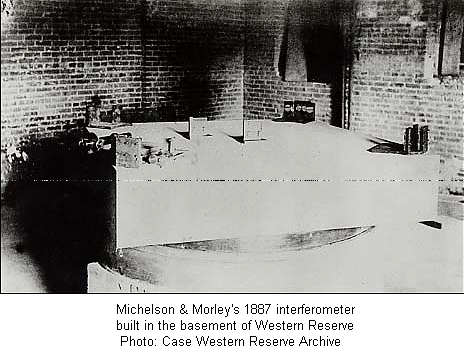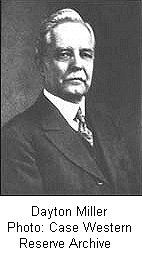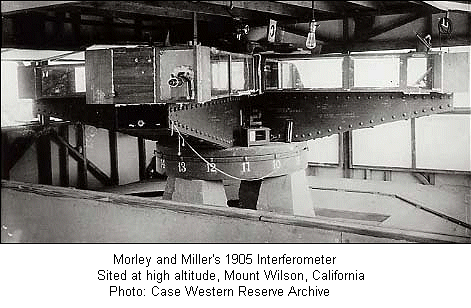Michelson-Morley & the Story of the Aether Theory |
|
by Richard
Milton Ether --- a null result, or an anulled result?
1880. US physicist Albert Michelson invents the Michelson light interferometer -- an instrument that can measure the velocity of a beam of light with great accuracy by splitting it through a half-silvered mirror and then re-combining the beams. If the recombined beams interfere with reach other, causing visible fringes on a screen, then one of them must have been delayed. 1887. Michelson and fellow American scientist Edward Morley build an interferometer with greater accuracy than ever before and use their instrument in a crucial experiment to determine whether light travels through the ether, or merely through the vacuum of empty space. The two physicists set up their instrument to measure the speed of a beam of light travelling in the same direction as the earth through space, and also a beam that travels at right angles to the earth’s direction of travel. If the ether exists there should be a minute – but measurable – drag effect on a beam of light that will delay it and show up as ‘interference fringes’ in the interferometer. The experiment shows a 'null result' -- no matter how the interferometer is orientated with respect to the earth's movement, there is no measurable ether drag.
These are the notes taken by generations of students. But, as Michelson and Morley’s experiment affected theoretical physics more than perhaps any experiments since Galileo and Newton, then one might expect its results to have been analysed with the utmost care and the experiment itself to have been replicated many times, establishing the 'null' result. Strangely, the real facts of the Michelson Morley experiment are the very opposite of this oft-told seminal tale. Michelson and Morley did not in fact obtain a null result in their original experiment. They found a small, anomalous deviation from the expected value, but this finding was simply forgotten about. Few attempts have been made to replicate the experiment itself but several of them have also found experimental evidence for an ether. Most extraordinary of all is the series of experiments carried out over a 30 year period by Dayton Miller, from 1906 to the mid 1930s, using far more accurate apparatus than Michelson and Morley and which clearly and consistently showed an ether drift effect. But these results contradicted Einstein and Relativity, so they were first ignored and later, after Miller’s death, made the subject of a campaign of denigration. The experiments of Michelson and Morley and of Dayton Miller, have been repeated and analysed in modern times by French engineer Maurice Allais, who was awarded the Nobel Prize for Economic Science in 1988. It is primarily due to the work of Allais that Miller's discoveries have been brought to a modern audience. For further details see Allais website here. The story of Dayton Miller and what happened to his findings has also been researched and told in considerable detail by Dr James De Meo, Director of the Orgone Biophysical Research Lab. His research paper can be found here. Albert Michelson became professor of physics at the newly-founded Case School of Applied Science in Cleveland, Ohio, in 1882. Here he met Edward Morley who was professor of chemistry at the neighbouring Western Reserve University. (Today, the two institutions are combined as Case Western University). Morley had several ideas for improving the Michelson Interferometer and in 1887 a new instrument was built in the basement of Western Reserve's Adelbert College in Cleveland. The instrument consisted of a 1.5 meter square block of sandstone on which was mounted the optical apparatus. The stone block rested on a wooden disk floating on mercury in a cast iron tank. This made it possible to rotate the instrument through 360 degrees with virtually no vibration. At each end of the arms of the apparatus were four mirrors to reflect the light beam back and forth repeatedly, thus effectively extending the path length for the beam to a total of 11 meters. If the theory of a stationary ether through which the earth moved were correct, then pointing one arm of the apparatus in the direction of the earth's travel through space would produce a displacement of the observed pattern of interference fringes amounting to 0.4 of a fringe width. The apparatus was sensitive enough to detect a displacement much smaller than this amount. Michelson and Morley made observations with the instrument for one hour at noon on 8, 9 and 11 July 1887 and one hour in the evenings of 8, 9 and 12 July -- six hours in all. In each session, the instrument was gradually turned through 36 rotations, readings being taken at every sixteenth of a turn. Today, whenever and wherever the results of these six days of observations are reported -- whether in the popular press or professional scientific paper -- it is confidently said that the Michelson-Morley experiment produced a null result.
The real facts were given in 1933 by Dayton C Miller who wrote, "The indicated effect was not zero; the sensitivity of the apparatus was such that the conclusions, published in 1887, stated that the observed relative motion of the earth and ether did not exceed one fourth of the earth's orbital velocity. This is quite different from a null effect now so frequently imputed to this experiment by writers on relativity." (The italics emphasis is Miller's.)
How on earth did the 'null result' story come about? In their paper of 1887, Michelson and Morley made an important qualification. 'In what precedes, only the orbital motion of the earth is considered. If this is combined with the motion of the solar system, concerning which but little is known with certainty, the result would have to be modified; and it is just possible that the resultant velocity at the time of observations was small though the chances are much against it. The experiment will therefore be repeated at intervals of three months, and thus all uncertainty will be avoided.' Unfortunately, this repetition (which later was to prove to be very important) was never carried out. In 1889, Michelson left the Case School, first for Clark University and then for University of Chicago where he remained for 38 years. After 1889, Michelson's interferometry work centred on determining the unit of [standard] length for which he became world famous. In the meantime, Einstein had published his Special Theory of Relativity in 1905, followed by his General Theory of Relativity in 1915. His theory, which quickly attained widespread currency and a wide measure of support made two key assumptions; first that the speed of light is constant, regardless of the speed of the source, and second, that there is no ether at absolute rest with respect to moving objects such as the earth. This second assumption is crucial. It requires that the results of the Michelson-Morley experiment show a NULL result -- that there is absolutely NO difference in the passage of a light beam whatever its orientation with regard to the earth's motion. And it is from around this time that people began to speak of a 'null' result for Michelson-Morley.
Back at Case, Edward Morley and Dayton Miller continued the ether drift experiments. A new instrument was constructed using steel girders with arms 4.3 meters long giving a light path that was effectively 32 meters long -- considerably longer and more accurate than that of the 1887 experiments. In 1905, the new interferometer was moved to an unobstructed site on a hill in Cleveland Heights. Miller's reason for wanting a high point is important. If the ether exists, some of it may be carried along with the earth as it moves through it, in the same way that some air is carried along with an aircraft's wing. This effect, named 'entrainment' could reduce the relative movement by an unknown amount at ground level -- perhaps a significant amount. If entrainment occurred then a high point and no obstructions should reduce its effects. Miller thus wished to avoid concrete basements and dense covering materials which might affect his readings. On Cleveland Heights some 230 observations were made in July, October and November 1905. These showed a very definite positive displacement of fringes corresponding with the instrument being pointed in certain directions, but again too small to be reconciled with the ether theory. For mainly funding reasons, research slowed and halted for a decade or more. In 1919, an astronomical expedition to Equatorial Africa made observations of light from a star occulted by the sun during a total eclipse. The photographs appeared to shown bending of the starlight around the sun as predicted by Einstein and relativity theory thus received a major publicity boost, with words like 'scientific confirmation' appearing in daily newspapers. Because it had now become central to progress in physics, Miller returned to experiments with the ether drift in 1921. Albert Einstein visited Miller at Case on 25 May 1921 and urged him to undertake further experiments. The same year, the Morley-Miller interferometer was transported across the continent to Mount Wilson observatory and set up at high altitude (1,750 meters above sea level). 67 sets of observations were taken which produced a positive experimental effect corresponding to a movement of earth relative to the ether of 10 kilometers per second. The apparatus was returned to Cleveland and the experiments repeated again between 1922 and 1924 with the same results. Again in 1925 and 1926, unobstructed observations were made at high altitude at Mount Wilson. This time, Miller had a brainwave. All previous observations had been made based on the assumption that the earth's velocity through the ether was known -- that it was the resultant of the earth's orbital movement around the sun and the motion of the solar system towards the constellation Hercules. But what if we take the interferometer readings at face value -- as telling us the actual motion of the earth? During 1925-26 an enormous number of new readings were taken and computed resulting in some 250,000 observations. Miller presented the results of analysing this mass of data to a conference in February 1927. The point on the celestial sphere towards which the earth moves through its absolute motion is named its apex of motion. Based on the mass of data accumulated, Miller announced to the conference that he had calculated the earth's apex of motion as lying in the northern celestial hemisphere at Right Ascension 17 hours and Declination +68 degrees. In 1932, Miller revisited the calculations to consider the possibility that he had correctly calculated the axis of the earth's movement through space but had got the wrong direction. His recalculation suggested that an apex of movement in the southern celestial hemisphere was more probable and was finally determined to lie at Right Ascension 4 hours 54 minutes and Declination -70 degrees 33 minutes, in the constellation of Dorado (the Swordfish). Moreover, Miller devised a technique that enabled him to estimate the absolute velocity of the earth's motion as being some 208 kilometers per second. He was also able to determine from the data that the disc of the solar system was tilted up almost at right angles against the direction of motion. He wrote, 'This suggests that the solar system might be thought of as a dynamic disc that is being pulled through a resisting medium, and which therefore sets itself perpendicular to the line of motion.' A number of other attempts were made to replicate Miller's findings, some with small positive readings, some with close to zero. These included an experiment by R J Kennedy in 1926 on Mount Wilson with the interferometer sealed in helium; an interferometer sealed in a vacuum casing and sent up by balloon to 2,500 meters in 1927; and an interferometer mounted inside a temperature-constant vault at Mount Wilson by Michelson himself in 1929. Displacements in each case were almost zero. However, Miller noted that in each case the instrument was enclosed in metal casings or in a basement room. He believed that such "opaque" shielding nullified the experimental effect. [The source of the problem was not the metal casing but the mere fact that the light was travelling through a vacuum or near-vacuum. -CR] Until his death in 1941, Miller's findings remained uncomfortably in the scientific background -- impossible to refute, equally impossible to accept, since they fatally undermined Einstein's Relativity which by now had become universally accepted in physics. After Miller's death his former student Robert S. Shankland, became Chairman of the Physics Department at Case Western Reserve University. According to James de Meo, 'Shankland's academic career soared after he organized a post-mortem on Miller's work, pronouncing it worthless, and after Einstein later granted him a series of widely-published interviews. Shankland subsequently became a bureaucrat within the emerging atomic energy infrastructure. Intimate with Einstein, in a 1981 interview Shankland claimed Miller's work on ether-drift had probably cost Einstein the Nobel Prize for relativity theory (Einstein did later get a Nobel Prize, but for his other theoretical work).' Shankland and three other authors published a paper in 1955 which, on the surface, was a critical review and re-analysis of Miller's long and painstaking observations. In reality, there was no review and no re-analysis; simply a trawl through the data looking for possible sources of error. Moreover, neither Shankland nor his fellow authors actually did any of the work on which the paper was based. Instead this was left to one of Shankland's students who received no credit beyond a footnote. The 1955 Shankland paper begins with the statement that has been repeated so often since, that Michelson and Morley obtained a "null" result. The paper also claimed that "All trials of this experiment except those carried out at Mount Wilson by Dayton C. Miller yielded a null result within the accuracy of the observations." Says James de Meo, 'This kind of chronic misrepresentation of the slight positive results of many interferometer experimenters, including Michelson-Morley, Morley-Miller, Sagnac, Michelson-Gale, and Michelson-Pease-Pearson, suggests an extreme bias and deliberate misrepresentation. The fact that this is a very popular bias does not excuse it. By redefining all the positive results observed by what may in fact have been the majority of ether-drift researchers, as mere expressions of "observational inaccuracy", Shankland narrowed his task considerably' In the end, Shankland and his team settled on the notion of seasonal temperature variations as being responsible for Miller's findings. There was no longer anyone alive to point out how fatuous this explanation is and Miller's data was safely interred along with his body. As far as orthodox science is concerned today, relativity is universally accepted and the ether controversy is dead and buried. A curious footnote James de Meo points out a curious semantic footnote to this affair. The name for the hypothetical medium through which light was thought to travel has been spelled in two ways: as 'ether' and also as 'aether'. In late medieval times when the word was coined it was spelled aether. In the period 1850-1920 when the topic was current in physics and used regularly by physicists such as Sir Oliver Lodge, Michael Faraday, Nicola Tesla, Michelson and Morley, and even by Einstein, the term was spelled 'ether'. In the 1950s, after Miller's death, when a concerted effort was being made to denigrate his work, the medieval 'aether' spelling suddenly re-appeared. On the face of it, the use of this spelling was to avoid confusion with the anaesthetic fluid ether. But it also appears to have been part of an attempt to “relegate the ether of space into ancient history, as an unproven speculation similar to Aristotelian elements of ‘fire, air, water and earth’.” |
